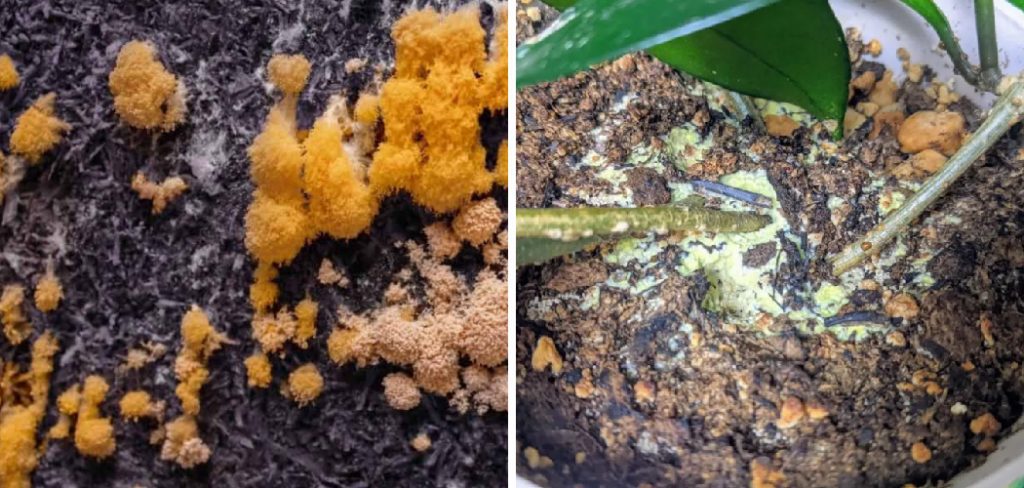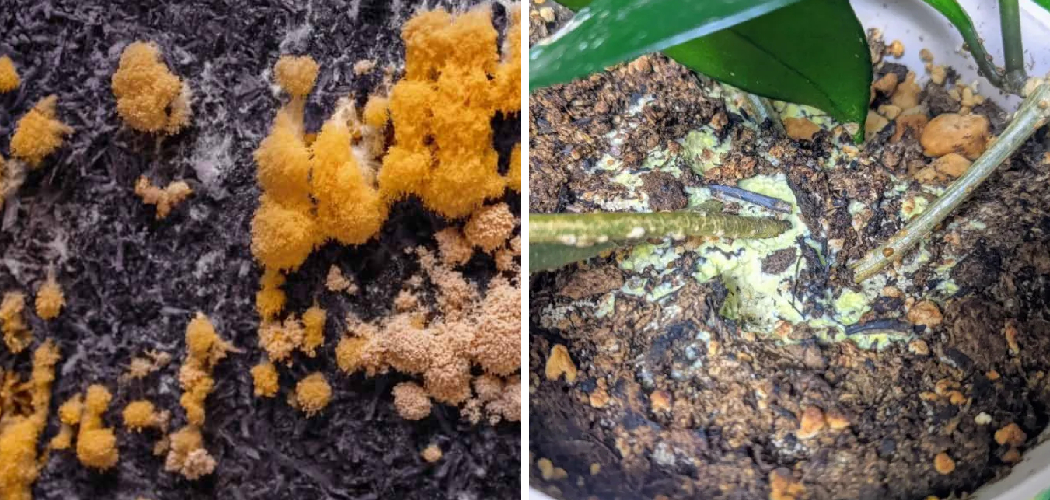To remove yellow mold from plant soil, you can use a mixture of hydrogen peroxide and water. Yellow mold can be a common issue for indoor plants, and it is important to address it promptly to prevent further damage.
This type of mold can thrive in damp and humid conditions, which makes plant soil a favorable environment. While it may seem challenging to remove yellow mold from plant soil, there is a simple solution. By using a mixture of hydrogen peroxide and water, you can effectively eliminate the mold and restore the health of your plants.

We will discuss the step-by-step process of removing yellow mold from plant soil and provide useful tips to prevent its recurrence.
The Signs And Impact Of Yellow Mold
Yellow mold can be a pesky problem for plant owners. Its presence not only affects the appearance of the plant soil but also has detrimental effects on the overall health of the plants. Identifying yellow mold in plant soil is essential to address the issue promptly.
One way to identify yellow mold is by its distinct color and appearance. It often appears as powdery or fuzzy growth on the soil surface. Another sign is a musty odor coming from the affected area. Additionally, yellow mold may cause the plant leaves to turn yellow or wilt.
Once yellow mold is identified, it is important to take immediate action to remove it. First, remove the affected soil by gently scraping it off, taking care not to damage the plant roots. Next, sterilize the remaining soil with a fungicide or by baking it in an oven at a low temperature. Finally, ensure proper drainage and ventilation to prevent moisture accumulation, which can encourage mold growth.
Addressing The Root Causes Of Yellow Mold
Addressing the root causes of yellow mold is essential for effective removal from plant soil. Understanding the environmental factors that contribute to yellow mold growth is the first step in preventing its occurrence. Poor soil conditions play a significant role in promoting yellow mold. These conditions include excessive moisture, lack of drainage, overwatering, and improper aeration.
To prevent yellow mold, ensure that the soil is well-draining and aerated, allowing for optimal root health. Consider using permeable containers or pots with drainage holes to avoid excessive moisture. Regularly inspect the plant for any signs of overwatering or waterlogged soil. Additionally, keeping the plant in a well-ventilated area with adequate air circulation will help prevent yellow mold growth. By implementing these effective methods, you can maintain a healthy growing environment for your plants and keep yellow mold at bay.
Tried And Tested Strategies For Yellow Mold Removal
When dealing with yellow mold in plant soil, natural remedies can be effective in removing the unsightly fungus. **One option** is to remove the affected soil and replace it with fresh soil. **Another method** is to create a mixture of equal parts vinegar and water, then carefully apply it to the affected areas. This acidic solution can help kill the mold. **Additionally**, sprinkling cinnamon or baking soda on the soil can inhibit mold growth. These natural remedies are worth exploring if you prefer chemical-free options for mold removal.
If natural remedies do not prove effective, chemical treatments can be considered. **Commercial fungicides** specifically designed to treat mold and mildew can be applied to the affected soil. It is important to follow the instructions carefully and wear protective gear when using any chemicals. Another option is **neem oil**, a natural insecticide with antifungal properties. Diluting it and applying it to the affected soil can help eliminate yellow mold.
- Identify the affected plants and isolate them from healthy plants to prevent further spread.
- Gently remove the moldy soil, ensuring not to damage the plant’s roots.
- Dispose of the moldy soil in a sealed bag to prevent contamination.
- Thoroughly clean the plant pot, removing any remaining mold or spores.
- Apply a natural remedy or chemical treatment to the affected soil, following the instructions accordingly.
- Monitor the plants for any signs of regrowth or new mold colonies, taking immediate action if necessary.
Restoring And Maintaining Healthy Plant Soil
Restoring and maintaining healthy plant soil is vital for the overall well-being of your plants. After removing yellow mold from the soil, it is important to take steps to promote healthy soil conditions to prevent its recurrence.
One way to achieve this is by enriching the soil with essential nutrients. Add organic matter such as compost or well-rotted manure to replenish the soil’s fertility. This will provide the plants with the necessary nutrients for their growth.
Maintaining proper soil moisture is also crucial. Yellow mold thrives in a damp environment, so make sure to water your plants correctly. Avoid overwatering as it can lead to waterlogged soil, creating favorable conditions for mold growth.
Improving soil drainage is another effective measure. Ensure that the pots or containers have adequate drainage holes to allow excess water to escape. This will help prevent water accumulation and improve air circulation around the roots.
Regularly inspect your plants for any signs of yellow mold. Early detection can make it easier to address the issue before it spreads. Remove any affected plant parts immediately and dispose of them properly.
By following these tips for preventing yellow mold recurrence and practicing nutrient enrichment and soil maintenance techniques, you can restore and maintain healthy plant soil for thriving plants.
How to Remove Yellow Mold from Plant Soil : Step by Step Guide
Soil Sterilization: An Extreme Solution
Yellow mold in plant soil can be a persistent problem that affects the overall health of your plants. When other methods fail to eradicate the mold, soil sterilization can be considered as a more extreme solution.
When and why to consider soil sterilization
Soil sterilization is typically recommended when the yellow mold persists and poses a threat to the vitality of your plants. It is essential to consider this method when other non-chemical options have proven ineffective. Sterilization can help eliminate harmful pathogens and fungi, including yellow mold, while preserving the soil’s fertility.
Different methods of sterilizing soil
| Method | Pros | Cons |
|---|---|---|
| Chemical sterilization | Effective in killing | May harm beneficial microorganisms |
| Solarization | Natural method | Requires sufficient sunlight and time |
| Steam sterilization | Thoroughly kills molds | Expensive and specialized equipment needed |
| Autoclaving | Effective and reliable | Not suitable for large-scale applications |
Pros and cons of soil sterilization for yellow mold eradication
Soil sterilization can effectively eliminate yellow mold and other pathogens, improving plant health. However, it is crucial to consider the potential drawbacks including a temporary reduction in beneficial microorganisms, the cost of equipment, and the time required for certain sterilization methods. Additionally, it is recommended to follow the instructions and safety guidelines carefully to prevent any adverse effects on the environment or plants.
Credit: gardening.stackexchange.com
Frequently Asked Questions On How To Remove Yellow Mold From Plant Soil
What Does Yellow Mold On Plant Soil Mean?
Yellow mold on plant soil indicates a fungus growth that may harm your plant’s health.
What Is The Yellow Mold In My Houseplant Soil?
The yellow mold in your houseplant soil may be caused by excess moisture or poor air circulation.
What Kills Yellow Mold?
Bleach kills yellow mold effectively. You can use a mixture of bleach and water to remove it.
How Does Yellow Mold Form In Plant Soil?
Yellow mold in plant soil is caused by a fungal infection. It thrives in damp environments, breaking down organic matter and producing spores. High humidity, overwatering, and poor drainage can create the perfect conditions for yellow mold to grow.
Conclusion
Tackling yellow mold in plant soil requires a proactive and systematic approach. By identifying the underlying causes and implementing preventive measures, such as providing proper drainage, adequate sunlight, and a healthy watering routine, you can minimize the risk of yellow mold growth.
Additionally, regularly cleaning and disinfecting gardening tools and containers can help prevent the spread of mold spores. If yellow mold does appear, quick action is necessary to remove the affected soil and treat the plant with an organic fungicide. Remember, patience is key when dealing with yellow mold, as it may take time for the plants to recover and regain their vitality.
By following these steps, you can maintain a healthy and vibrant garden, free from the destructive effects of yellow mold.

